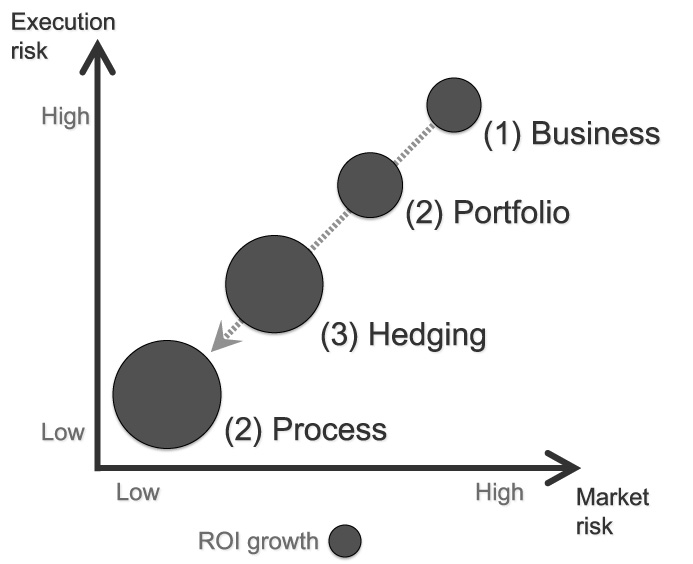
Co-written by Jed Simms.
Creating innovative products is fraught with risk due to the inherent gap between the knowledge one has and the knowledge one needs to make good decisions. Usually one knows only 5 percent of what is needed at the stage where 70 percent of the product's cost is determined. At this juncture, one has to make a qualified bet on the design team's ability to close the gap faster than the money is being spent.
Fortunately, there is some predictability, since return on investment (ROI) and risk go hand in hand. Small incremental investments in product improvements offer small rewards at a low risk where market and technology are known, while breakthrough innovations have the potential of offering huge rewards along with large investments and potentially scary risk. With only a vague sense of the odds, this may look like pure gambling. However, unlike roulette, product development has four winning strategies that, when combined, vastly improve the return on investment.

Applying the four steps: (1) Business definition, (2) Portfolio management, (3) Hedging product concepts and (4) Managing process, ROI in design is effectively managed, execution and market risk is systematically reduced while real ROI becomes transparent, measurable and controllable.
One -- Stating and agreeing upfront on what the new business-as-usual end states are to be and how the results are to be made operational, in clear specific measurable terms is the most important step to optimizing ROI. This is accomplished though formulation of a dynamic and inspirational design brief for the projects considered, describing how projects fit with the corporation's strategy. The briefs describe the desired outcomes of nine design quality criteria: strategy (philosophy, structure and innovation), context (social/human, environmental and viability) and performance (process, function and expression). Formulating the brief requires all stakeholders to convene and consider potential options in business outcome terms and then co-create a brief that is flexible enough to adjust to changes in assumptions, new learning as well as to solidify the team and inspire action. Creating a brief is actually a small design specification project in itself for management to conduct.
Two -- Product portfolio management, like any investment portfolio, is balancing one's portfolio for long-term ROI, determining which projects to initiate in the first place. This can be accomplished by spreading the corporation's investment into combinations of low and high market and execution risks. The right mix depends on the dynamics of the market and the strategy of the corporation.
Three -- Option management by segmenting the product development process into a number of phases, small steps where investment is made for one phase at a time, each phase reducing risk though prototyping and testing. In addition one can hedge one's risks by investing in parallel alternative designs during a phase and then pick the most promising product concept at its end for further development.
Four -- Comprehensive risk/reward focused project management is the strategy for translating the brief into real-time decisions and actions -- it is where the rubber hits the road. As with rally driving, mastering project management takes lots of practice in holding the original business outcomes in mind while continuously managing activities and optimizing the allotted time and cost to meet the expected quality.
Besides doing all of the above well, the key to totally optimizing ROI and risk is to recognize when the team has discovered unanticipated hurdles or unforeseen game-changing opportunities. Communicating these changes to management is crucial so they can reassess their investment, take advantage of the situation and plan outcomes to optimize the resultant ROI.
As in life, luck in new product development is when opportunity meets preparation. Not just once, but every month, week, day and sometimes every hour. Long-term superior ROI is achieved when direction, preparation and execution is consistent and is clearly communicated to all project participants.
Special thanks to Jed Simms for researching and co-writing this article.